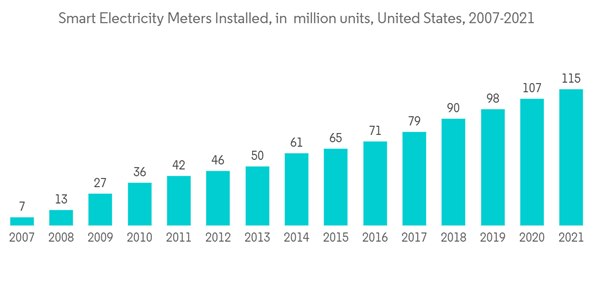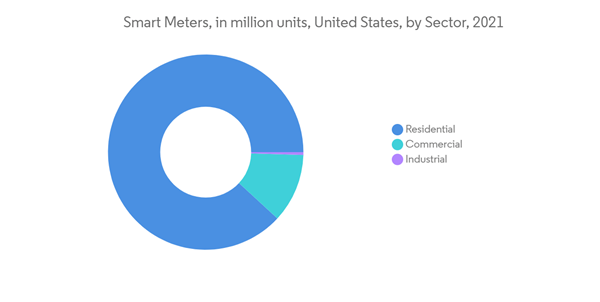The North American smart meters market is expected to register a CAGR of 11.2% during the forecast period (2022-2027). Due to the COVID-19 pandemic, the smart metering market witnessed growth. It enables real-time energy consumption and bi-directional communication with energy suppliers for accurate billing and analysis without physically accessing the meter. North America's smart meter market is expected to grow significantly due to government incentives and support, growth of smart grids, energy transition, and demand for higher energy quality. However, the high installation cost involved compared to a conventional meter is likely to hinder the market’s growth during the forecast period.
The North American smart meters market is moderately consolidated. The major companies include Schneider Electric, Siemens AG, Honeywell International Inc., Sensus, and Landis+Gyr.
This product will be delivered within 2 business days.
Key Highlights
- The smart electricity meter segment is expected to be the fastest-growing in North America due to the increasing adoption of renewable energy and government support to convert grids into smart grids.
- As the adoption of electric vehicles increases in North America in the future, the adoption of smart meters will increase as they facilitate customers to charge their EV in off-peak times and save them a significant amount of money, thus creating an opportunity for the smart meters market.
- The United States is expected to be the fastest-growing geographical segment due to the high population density, electricity, water, and consumption among industries, residents, and commercial buildings.
Key Market Trends
Smart Electricity Meters to Dominate the Market
- Smart electricity meters provide two-way communication between the customer and the energy provider, which helps the utility scale provider improve power quality by knowing about blackouts and maintaining a more reliable electrical service.
- In addition, a smart electricity meter provides a home energy management system through a web-based tool so that the customer can find ways to reduce energy consumption by using certain appliances during off-peak times, switching on certain machines, or adjusting the thermostat temperature. This factor may drive the segment’s growth during the forecast period.
- According to Natural Resources Canada, more than 82% of Canadian residents have adopted smart meters. A similar trend was observed in the United States. According to the Institute for Electric Efficiency, smart electricity increased from 7 million units in 2007 to 115 million units in 2021.
- Overall, as renewable energy adoption and the demand for higher power quality increase, the smart electricity meter market is expected to grow during the forecast period.
The United States Expected to Dominate the Market
- The United States is the largest market for smart meters. It has the highest population and adoption rate compared to the other countries in the region due to government support and policies, the development of smart grids, and customer awareness. For instance, the US government launched the Smart Grid Investment Grant (SGIG) Program to accelerate the development of smart meters in the country.
- According to the EIA, the country has around 102.933 million advanced (smart) metering infrastructure (AMI) smart electricity meters, which record electricity usage on an hourly basis and send data to the utility company and the consumer.
- Further, in August 2021, Louisville Gas and Electric Company (LG&E) and Kentucky Utilities Company (KU) signed a deal with Landis+Gyr to deliver 930,000 smart meters, 300,000 gas modules, and an IoT network for connectivity.
- According to the Institute for Electric Innovation, around 75% of US households have smart meters installed, and this number is expected to increase during the forecast period.
- Therefore, the United States is expected to dominate the North American smart meters market during the forecast period due to the abovementioned factors.
Competitive Landscape
The North American smart meters market is moderately consolidated. The major companies include Schneider Electric, Siemens AG, Honeywell International Inc., Sensus, and Landis+Gyr.
Additional Benefits:
- The market estimate (ME) sheet in Excel format
- 3 months of analyst support
This product will be delivered within 2 business days.
Table of Contents
1 INTRODUCTION
4 MARKET OVERVIEW
5 MARKET SEGMENTATION
6 COMPETITIVE LANDSCAPE
Companies Mentioned (Partial List)
A selection of companies mentioned in this report includes, but is not limited to:
- ABB Ltd
- Schneider Electric
- Siemens AG
- Honeywell International Inc.
- Sensus
- Landis+Gyr
Methodology

LOADING...










